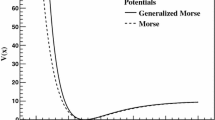Summary
Using a (p, q, t)→(P, Q, s) space-time transformation and an auxiliary variable φ, 0≤φ≤2π, the Morse and Pöschl-Teller potential spectra are determined simply in the phase-space formulation of Weyl-Wigner-Moyal, through the solution of the Hamilton-Jacobi equation, and this for several values of the well's depth. By elimination of the φ-variable by projection, the propagator of the Morse potential is obtained from the evolution function, in the (P, Q, s) system. For normalization and analyticity reasons, the Green's function of the Morse potential is obtained, in the (p, q, t) system. The spectra is deduced from it for each value of the well's depth.
Résumé
Au moyen d'une transformation spatio-temporelle (p, q, t)→(P, Q, s) et de l'introduction d'une variable auxiliaire ϕ, 0≤φ≤2π, les spectres des potentiels de Morse et de Pöschl-Teller, sont déterminés simplement dans le formalisme d'espace des phases de Weyl-Wigner-Moyal, par la résolution de l'équation de Hamilton-Jacobi, pour certaines valeur de la profondeur du puits. En éliminant la variable φ par projection, le propagateur du potentiel de Morse est calculé dans le système (P, Q, s) à partir de la fonction d'évolution. Par des considérations de normalisation et d'analyticité la fonction de Green du potentiel de Morse est obtenue dans le système (p, q, t). Le spectre en est débuit pour toute valeur de la profondeur du puits.
Riassunto
Usando una trasformazione delle spazio-tempo (p, q, t)→(P, Q, s) ed una variabile ausiliare ϕ, 0≤φ≤2π, si determinano gli spettri di potenziale di Morse e Pöschel-Teller semplicemente nella formulazione dello spazio delle fasi di Weyl-Wigner Moyal, attraverso la soluzione dell'equazione di Hamilton-Jacobi, e questo per molti valori della profondità del pozzo. Eliminando la variablile φ per proiezione, si ottiene il propagatore del potenziale di Morse per la funzione di evoluzione, nel sistema (P, Q, s). Per ragioni di normalizzazione ed analiticità, si ottiene la funzione di Green per il potenziale di Morse nel sistema (p, q, t). Gli spettri sono dedotti da questo per ogni valore della profondità del pozzo.
Резюме
Используя преобразование пространства-времени (p, q, t)→(P, Q, s) и вспомогательную переменную φ, 0≤φ≤2π, опреденяются спектры потенциала Морса и Пешля-Теллера в формулировке фазового пространства Вейля-Вингера-Мойала, посредством решения уравнения Гамильтона-Якоби и для некоторых значений глубины потенциальной ямы. Исключая вспомогательную переменную φ с помощью проектирования, получается пропагатор для потенциала Морса, исходя из функции эволюции в системе (P, Q, s). Для нормализации и аналитичности определяется функция Грина для потенциала Морса в системе (p, q, t). Выводятся спектры из функции Грина для каждого значения глубины потенциальной ямы.
Similar content being viewed by others
References
S. De Groot:La transformation de Weyl et la fonction de Wigner: une forme alternative de la mécanique quantique (Les Presses de l'Université de Montréal, 1974).
N. K. Pak andI. Sökmen:Phys. Rev. A,30, 1629 (1984);J. M. Gracia-Bondia:Phys. Rev. A,30, 691 (1984).
P. Y. Cai andA. Inomata:Phys. Lett. A,96, 117 (1983).
I. Sökmen:Phys. Lett. A,106, 212 (1984).
M. M. Mizrahi:J. Math. Phys. (N. Y.),16, 2201 (1975).
J. E. Moyal:Proc. Cambridge Philos. Soc.,45, 99 (1949).
D. Kastler:Commun. Math. Phys.,1, 14 (1965);G. Loupias andM. Solé:Commun. Math. Phys.,2, 31 (1966).
F. Bayen, M. Flato, C. Fronsdal, A. Lichnerowicz andD. Sternheimer:Ann. Phys. (N. Y.),111, 61, 111 (1978).
G. Pöschl andE. Teller:Z. Phys.,83, 143 (1933).
P. M. Morse:Phys. Rev.,34, 57 (1929).
Y. Alhassid, F. Gürsey andF. Iachello:Ann. Phys. (N. Y.),149, 346 (1983).
L. Gervais andA. Jevicki:Nucl. Phys. B,110, 93 (1976).
I. S. Gradsheteyn andI. M. Ryzhik:Tables of Integrals, Series and Products (Academic Press, New York, N. Y., 1965).
J. M. Gipson:Phys. Rev. Lett.,48, 1511 (1982).
N. K. Pak andI. Sökmen:Phys. Lett. A,100, 327 (1984);A. Inomata andM. A. Kayed:Phys. Lett. A,108, 9 (1985).
P. Sharan:Phys. Rev. D,20, 414 (1979).
Author information
Authors and Affiliations
Additional information
Traduzione a cura della Redazione.
Переведено редакцией.
Rights and permissions
About this article
Cite this article
Chetouani, L., Hammann, T.F. Potentiels à une dimension dans le formalisme d'espace des phases de Weyl-Wigner-Moyal. Nuov Cim B 92, 106–120 (1986). https://doi.org/10.1007/BF02729700
Received:
Published:
Issue Date:
DOI: https://doi.org/10.1007/BF02729700




